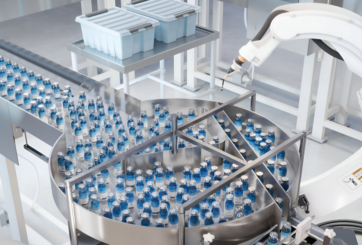Life Sciences Embracing Digital Transformation
The life sciences sector is arguably one of the globe’s leading, major industries that has embraced the multiple benefits that digital transformation has made possible.

Indeed, the products that it produces, the supply chain that it is reliant upon and the customers it supplies are all becoming increasingly reliant on the latest digital innovations which have enabled huge advances to be made in levels of productivity, profitability, and accuracy.
As the relationship between the life sciences sector and digital transformation is so close, let us delve into some of the key developments that have been made over the past few years – and take a nod towards the pharma digital transformation trends that lie ahead in the future.
Digital transformation in the pharmaceutical industry
Advanco was one of the first pharmaceutical serialization solution providers to showcase how digital transformation will revolutionize the overall structure, indeed the very DNA, of the life sciences sector.
Fast forward to today, and the proof clearly shows that advanco’s prediction around digital transformation in the pharma industry has come true. Production lines across the globe have been transformed because of the positive effects of digitalization.
We are now seeing high levels of transparency and adaptivity for a digitalized plant floor, incorporating cyber-physical systems, Internet of Things, cloud computing, cognitive computing, and artificial intelligence. These are all working independently, yet in unison, to provide a digitally powered process that can adapt over the coming years to meet the specific demands of an ever-changing pharmaceutical sector.
Aligned Pharmaceutical Track and Trace Solutions
Just as advanco predicted that digital transformation will re-write the life sciences sector, we were also the first serialization solutions provider to call for a much more open track and trace sector. This cooperation between vendors will enable the true power of digital transformation to be felt across the serialization sector, with machines and solutions capable of exchanging data in real time, no matter who has designed and built them.
Indeed, it was the advent of the Covid 19 pandemic which highlighted the importance for product track and trace to work together. Increased cooperation will result in a much more agile supply-chain which optimizes costs for pharmaceutical companies, leading towards a new standard of openness and cooperation in the Industry 4.0. era.
The seeds of this cooperation are already being sown. We are already seeing the implementation of agile supply chain regulation which will require a strong industry-standard open interface and interoperability. To do this, the hardware, and the serialization software for pharmaceuticals among different vendors needs to be much more aligned and should work much closer together, resulting in much more open and cooperative serialization processes. Machines need to speak to each other in a common language, regardless of the manufacturer.
The streamlining of life sciences product line serialization
The overall effects of digital transformation are clear to see right across the life sciences sector. Technology is already directly responsible for an increase in the efficiency of systems, and quality of products and services. It helps track and streamline processes and maintain data flow.
Furthermore, the cloud has rewritten the way computing works, allowing firms to power their systems, and retain full records, without a single server needing to be on site. Furthermore, the cloud allows for a higher level of data transparency and lower infrastructure cost.
Serialization and life sciences digital transformation
Digital transformation in life sciences drives efficiency, engagement, and innovation. It streamlines operations, fosters targeted interactions, and catalyzes the development of new products and services. To succeed, companies must cultivate a digital DNA that aligns digital efforts with broader organizational goals, fostering a culture of innovation and strategic thinking across the organization.
Let us highlight two specific developments that have been made possible because of the impact of digital transformation in life sciences.
- Edge Computing:
Edge computing is a distributed IT architecture in which client data is processed at the periphery of the network, as close to the originating source as possible.
The impact of this technology on the pharmaceutical track-and-trace sector has already been significant, and is expected to rapidly grow, especially where overall supply-chain operations are concerned.
We have already seen a move towards a much more agile, local supply chain. The rapid uptake of digital barcode scanning systems combined with the very latest, cutting-edge technology, has made supply chains much more secure. New-edge computing will tighten this up even further. It will power automatic, time-sensitive traceable packaging solutions processes in warehouses, factories, and manufacturing facilities. These processes will lessen the need for human management and create optimal outcomes while eliminating the risk of error due to manual processes.
One way that edge computing will drive the process is the ability to introduce new pharma serialization software. One specific example is a scanner with a mobile application supporting the handling of serialized products across the supply chain and within warehouse operations. It runs on commercially available devices deployed at the warehouse, packaging, and other operational facilities.
- Plug and produce:
The second development that is worth highlighting as a direct result of digital transformation, and one that will have far reaching benefits for life sciences drug serialization is the advent of plug and produce. This is where a production system can automatically identify a new or modified component and integrate it correctly into the running production process without manual efforts and changes within the design.
In other words, plug and produce is rapidly rising to prominence as a method of automating production lines and reducing the overall time and effort needed to reconfigure a manufacturing line. A user can add and remove devices without having to do manual configuration, and without knowledge of computer hardware.
Certainly, to most pharmaceutical businesses, this will be irresistible. That is because we still largely reconfigure production lines manually. However, the ongoing Industry 4.0 revolution anticipates that these production lines will become semi-automatic and self-controlled. This will be made possible by utilising the plug-and-produce concept in the manufacturing systems. This would then enable new deployments introduced to the existing production line, along with its reconfiguration or extensions.
In other words, when a new machine, or a subsystem, is deployed or ordered, all components can be brought to the production line mechanically, electrically, and digitally. This can be done in a semi-automatic manner, in such a way that the entire system starts to operate without any external help.
The benefits of this are endless for life sciences pharmaceutical serialization. Not only will this approach support a much more agile, streamlined supply chain, it will benefit increased automation on the shop floor, which will help companies to keep costs down in the long run. It will lead to a much higher rate of compliance through a standard interface and will make it much more straightforward for firms to change suppliers, vendors, and customers.
Contact us for more information!
Advanco is proud to be driving digital transformation in life sciences and the pharmaceutical serialization sector. If you would like to learn more about our solutions, please do get in touch.



